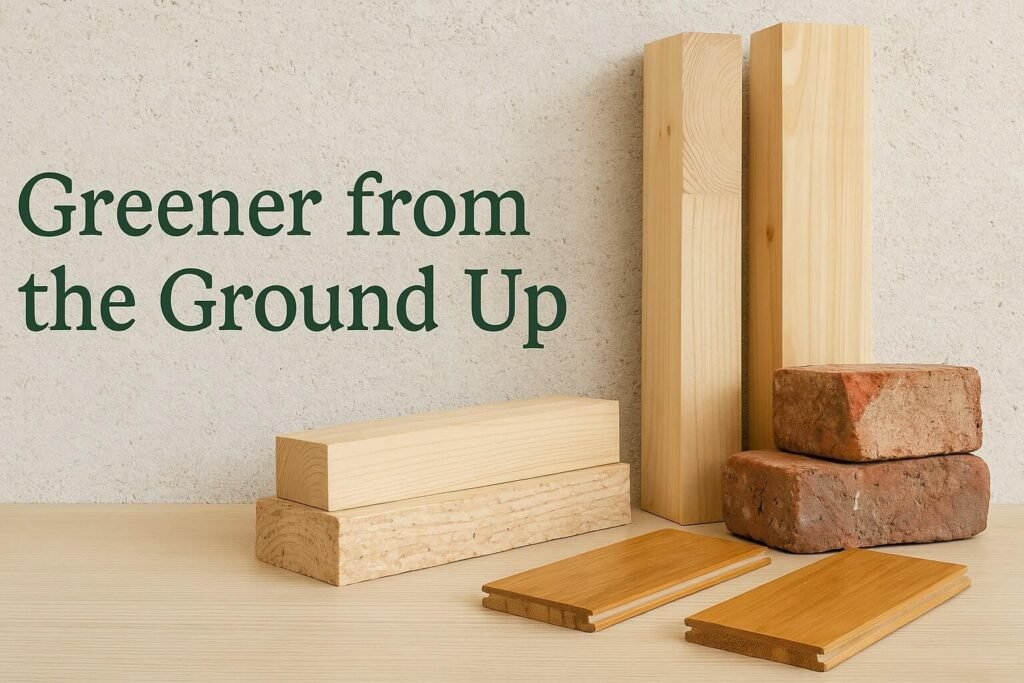When we tackled our side extension last summer, I didn’t expect that the trickiest choices would come down to the building materials. Layout and lighting? Sorted. But deciding what everything was made of—that was a whole other story. Timber or concrete? Natural or synthetic? Recycled or virgin? The moment you start thinking about building materials, you realise you’re not just creating a space—you’re making a long-term environmental commitment.
This guide walks you through the essential sustainable building materials worth knowing, why they matter more than ever, and how to choose the right ones without blowing the budget or losing your mind.
Why Building Materials Matter in 2025
We often think about energy bills when it comes to sustainable homes, but the carbon footprint of your house starts long before you move in. The term for that is embodied carbon—the emissions released during the manufacture, transport, and installation of building materials. Choosing low-impact materials can reduce your project’s footprint before you’ve even painted the first wall.
Beyond carbon, many traditional building materials release VOCs (volatile organic compounds) that linger in the air for weeks, even months. Health-wise, what you build with matters just as much as how well it’s insulated.
Timber: Timeless and Low-Impact
We used FSC-certified softwood for our extension’s structural frame. It wasn’t just the aesthetic—though that helped—it was the fact that responsibly harvested timber is one of the most sustainable building materials out there. It sequesters carbon as it grows and can be reused or repurposed down the line.
Modern timber options like cross-laminated timber (CLT) can now replace steel in some load-bearing applications. Our builder said we saved nearly a week on the job using it, and the whole house smells faintly of pine after a rain.
Bio-Based Innovations: Hemp, Bamboo, and More
My brother-in-law’s barn conversion introduced me to hempcrete—a carbon-negative mix that breathes, regulates moisture, and feels grounded. It’s one of those building materials that seems like a throwback but is quietly leading the future.
Bamboo is another incredible alternative. Though technically a grass, it’s stronger than steel in some applications, regrows in a matter of months, and makes beautiful flooring or cladding.
Recycled and Reclaimed Materials: Old is Gold
Sustainable doesn’t always mean new. Recycled and reclaimed building materials can massively reduce your footprint and often cost less if you’re willing to do a bit of the work. We used bricks salvaged from a neighbour’s skip for a small garden wall—and now it’s the most character-filled part of the entire project.
Plastic lumber, recycled steel, and upcycled timber panels are all climbing in popularity. These types of building materials are practical, durable, and already passed the test of time.
Better Insulation with Natural Materials
Forget the itchy pink stuff. Natural insulations—like wool, cellulose, and even mycelium (yes, mushroom-based panels!)—are reshaping the way we think about healthy homes. We filled our loft with blown-in cellulose insulation made from recycled newspaper. It’s breathable, safe to handle, and incredibly effective.
These natural building materials often perform just as well thermally while being significantly healthier and easier to dispose of.
Paints, Finishes, and That Final Layer
You spend so much time deciding on the bones of your home, but don’t forget the skin. Paints, plasters, and sealants are some of the most commonly overlooked building materials. Go for low-VOC or clay-based paints and you’ll notice the difference immediately. We used one in the kitchen, and the air quality felt better within a day.
Even flooring adhesives and cabinet glues can make a difference in your home’s long-term indoor air quality.
Tips for Choosing Sustainable Building Materials
- Set a carbon budget alongside your financial one. Use tools like EC3 to compare the footprint of different building materials.
- Go local where you can. Transport impacts add up fast.
- Look for Environmental Product Declarations (EPDs) on the materials you’re sourcing.
- Design for disassembly. Choose building materials that can be reused, repurposed, or recycled easily in the future.
- Mix it up. Combine reclaimed timber, natural insulation, and modern finishes for the best of all worlds.
It’s the Materials That Make the Home
If you’re just starting a renovation or build, try not to feel overwhelmed. You don’t need to swap every single item on your checklist for a green alternative. But by choosing even a few low-impact building materials, you reduce your home’s environmental burden and often improve its long-term comfort and durability.
It’s not about perfection—it’s about progress. Every brick, beam, or board you choose tells a story. Let yours be one of care, creativity, and responsibility.


